Fort Union
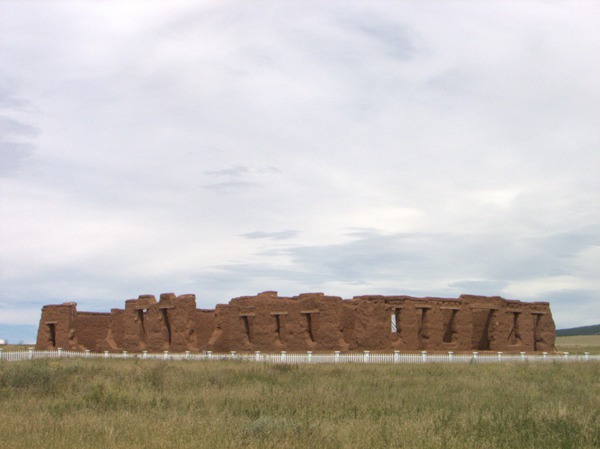
Hospital Ruins. (Sun 06 Sep 2015 02:09PM, Fullsize 246KB, Map) |
Fort Union was one of a series of Army outposts near the Santa Fe Trail and was located at the western junction of the Dry and Mountain Routes. Its function evolved over time. Originally, it was supposed to police traffic on the Santa Fe Trail and to project federal military authority in New Mexico Territory, which had recently been won from Mexico. In the Civil War, troops stationed there prevented a Confederate invasion of the High Plains from the Rio Grande Valley via the Glorieta Pass. During the ensuing Indian Wars, Fort Union became an ever larger, ever more significant overland supply base before the advent of rail transportation (Weiser).

Civil War Earthworks -- Here is a ground-level view of defensive earthworks built during the Civil War. They were never used. Instead, Confederate forces were routed at Glorieta Pass (Wikipedia, Battle of Glorieta Pass) at the head of the canyon of the Pecos River near Santa Fe. An aerial view of the earthworks is more impressive. They are seen as a small eight-pointed star southwest of the quadrangle, which was built later. The original fort was located across the creek to the west but was vulnerable to cannon fire from higher ground there. In spite of expense and effort invested in their construction, the earthworks were, too. This was due to improvements in artillery unaccounted for during planning. (Sun 06 Sep 2015 03:03PM, Fullsize 384KB, Map) |
Fort Union grew in three phases. The first phase dated from 1851, a year after the Compromise of 1850 that organized New Mexico and Utah territories and admitted California to the Union as a free state. The second phase was a star-shaped earthwork fortification, finished early in 1862, which was located east of the original encampment. It was never the site of a battle. Instead, the decisive battle for control of the Southwest took place southwest of the fort itself toward Santa Fe in March of 1862. The so-called star fort was supposed to be out of range of cannon fire from the bluffs on the west bank of Wolf Creek, but test rounds fired in the summer of 1862 easily overshot the fort (U.S. National Park Service, Second Fort Union).
[The Fort Union of New Mexico territorial days should not be confused with the earlier American Fur Company operation at the junction of the Yellowstone and Missouri Rivers on the border of present-day Montana and North Dakota. Fort Union in New Mexico is more nearly contemporaneous with Fort Buford there.]
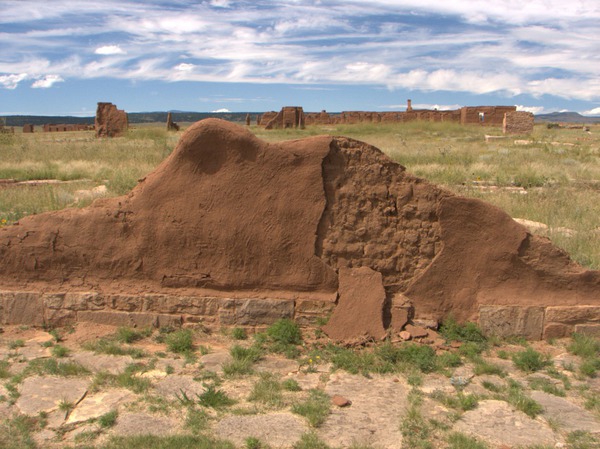
Stabilized Adobe-Wall Remnant -- Obviously the adobe ruins of Fort Union have not stood the test of time nearly so well as the stone buildings at Fort Larned or even the adobe walls of the Palace of the Governors in Santa Fe. This is because adobe is sun-baked brick. It is not fired: hence, it erodes in rain. Adobe structures require ongoing maintenance (Wikipedia, Adobe). Here you can see how the stucco, which has cracked away, should protect the adobe brick underneath. (Sun 06 Sep 2015 03:15PM, Fullsize 368KB, Map) |
Many Indian nations supported factions that took advantage of the distraction of the Civil War to disrupt commerce throughout the Southwest while regular army units were withdrawn to fight in the Southeast. Until well after the end of that conflict, the defense of commerce along the Santa Fe Trail and throughout the High Plains and Sangre de Christo Mountains fell mainly to local New Mexico volunteer armed forces supplied from Fort Union (Sperry, Oliva).

|
Hearths and chimneys, foundations, pavement, and porch abutments are nearly all that remain of the massive third and final phase of development at Fort Union, which was started in 1863 and required six years to complete at a cost of over a million dollars (Sperry). In its day it was the largest military outpost west of the Mississippi River (U.S. National Park Service, Second Fort Union). Its main function was logistics, and, when the railroad arrived in Watrous in New Mexico Territory in 1879, Fort Union was eclipsed and made superfluous to the Army's needs. Fort Union no longer functioned as a supply depot after 1883 (Sperry).
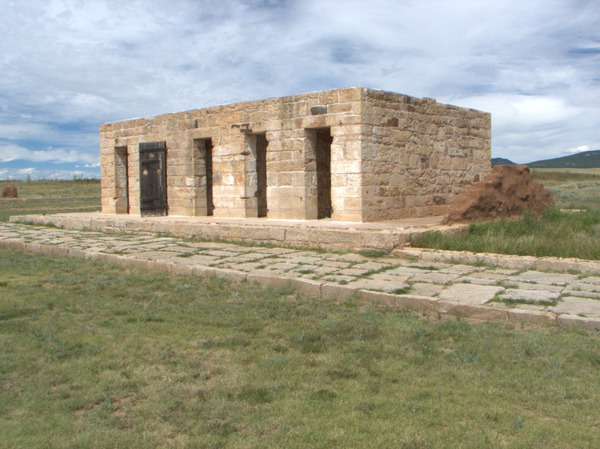
Jail -- One of the functions of Fort Union was to extend U.S. federal law and order to New Mexico Territory and enforce it there. Doing this required cells where lawbreakers could be incarcerated. Obviously, desperados could dig their way right through an adobe wall, so the jail had to be built of stone, or, at least, the cells inside had to be. (Sun 06 Sep 2015 03:18PM, Fullsize 334KB, Map) |
In 1891, Fort Union was abandoned and fell into ruin.
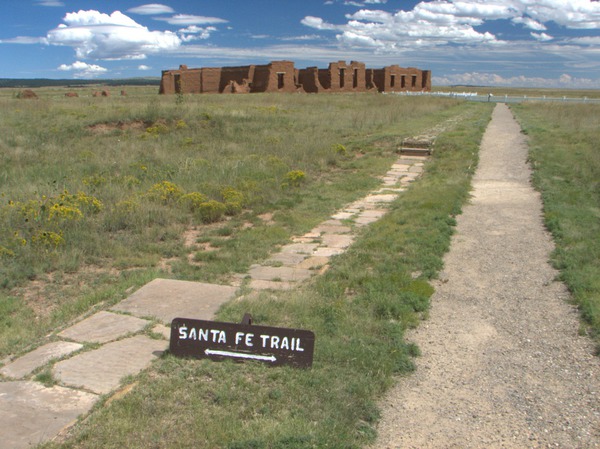
Ruts -- The stone walkway is historic. Modern visitors use the gravel pathway. At this point both paths cross a swale left by Santa Fe Trail traffic. Heavy use of the trail in this place exposed the soil to the wind, which picked it up and carried it off, lowering the general level of the terrain. (Sun 06 Sep 2015 03:24PM, Fullsize 374KB, Map) |
Tin roofing, copper flashing, lead pipes, hardwood flooring, and milled doors and windows were quickly looted from the site (Oliva).
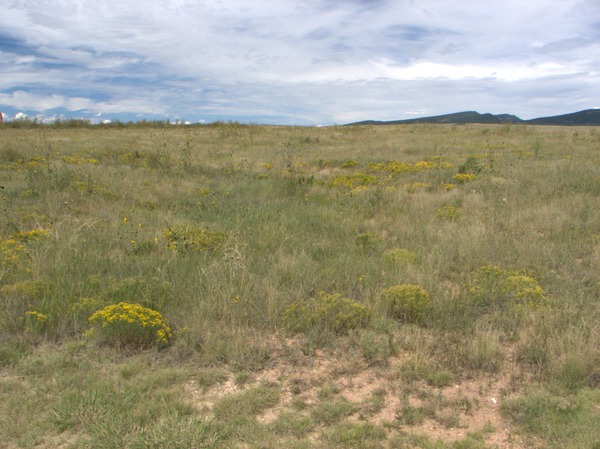
Ruts -- As compelling as the ruts may seem in the preceding photo, they all but disappear when you look along them. Bear in mind you are seeing ecological damage done a century and a half ago. You can appreciate the scale better by looking at the aerial view where this branch of the trail leads through the southeast corner of the quadrangle and crosses the gravel path. (Sun 06 Sep 2015 03:25PM, Fullsize 345KB, Map) |
A year earlier, in 1890, the Army had closed other western forts such as Fort Laramie in Wyoming. Idaho and Wyoming were admitted to the Union in 1890.
That year witnessed the deaths of General John C. Frémont and Sitting Bull, and General William Tecumseh Sherman was not far behind. Sir Richard F. Burton also passed away in 1890. Burton was a world famous British explorer who visited Salt Lake City on the eve of the Civil War probably as a spy. In 1861, he wrote a book, The City of the Saints, about that journey.
The year 1890 ended in the Wounded Knee Massacre. Wisconsin Historian Frederick Jackson Turner noted in 1893 that 1890 was the end of the decade that marked the closing of the American Frontier.